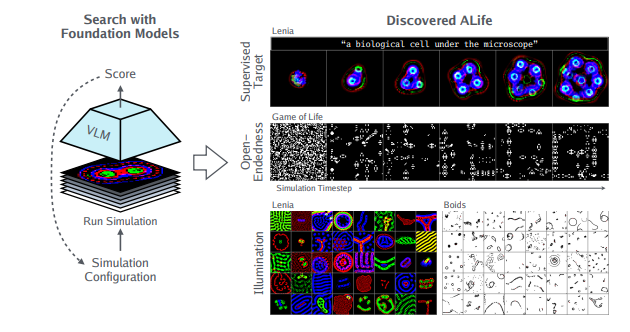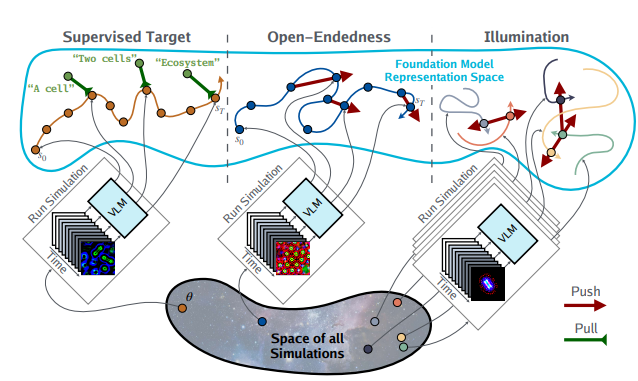The Sakana AI team has made a major breakthrough in artificial life (ALife) simulation research and successfully developed the ASAL (Automatic Search for Artificial Life) system, which uses visual language basic models (FMs) to automatically search for interesting ALife simulations, completely changing traditional artificial life. The study of life relies on artificial design and trial-and-error models. ASAL has discovered never-before-seen life forms in different ALife matrices through three mechanisms: supervised target search, open search and heuristic search, and supports quantitative analysis of phenomena that could only be analyzed qualitatively in the past. It has brought revolutionary changes to the research in this field.
Recently, scientists at Sakana AI have made breakthrough progress in the field of artificial intelligence. For the first time, they successfully used vision-language foundation models (FMs) to implement automatic search for artificial life (Artificial Life, ALife) simulations. This new method, called ASAL (Automated Search for Artificial Life), has brought revolutionary changes to the research in the field of artificial life and is expected to accelerate the development of this field.
Traditional artificial life research mainly relies on artificial design and trial and error, but the emergence of ASAL has changed this situation. The core of this method is to automatically search for interesting ALife simulations by evaluating the videos produced by the simulations through the underlying model. ASAL mainly discovers life forms through three mechanisms:

Supervised target search: Use textual prompts to find simulations that produce specific phenomena. For example, researchers can set a goal of "one cell" or "two cells" and let the system automatically find simulations that meet the criteria. Open-ended search: looking for simulations that yield endless novelty in time. This approach helps discover simulations that remain interesting to human observers. Heuristic Search: Find a set of interesting and diverse simulations that reveal "alien worlds".
ASAL's versatility allows it to be effectively applied to a variety of ALife matrices, including Boids, Particle Life, Game of Life, Lenia, and Neural Cellular Automata. Researchers have discovered never-before-seen life forms in these matrices, such as bizarre swarming patterns in Boids, new self-organizing cells in Lenia, and open cellular automata similar to Conway's Game of Life.
In addition, ASAL enables quantitative analysis of phenomena that were previously only possible to analyze qualitatively. The underlying model has human-like representation capabilities, which enables ASAL to measure complexity in a way that is more consistent with human cognition. For example, researchers can quantify plateaus in Lenia simulations by measuring how quickly the CLIP vector changes during the simulation.

The innovation of this research is the use of pre-trained basic models, specifically the CLIP (Contrastive Language-Image Pre-training) model, to evaluate simulated videos. The CLIP model aligns representations of images and text through contrastive learning, enabling it to understand human concepts of complexity. ASAL's approach is not restricted to a specific base model or simulation matrix, meaning it is compatible with future models and matrices.
The researchers also experimentally verified the effectiveness of ASAL, using different basic models (such as CLIP and DINOv2) and different ALife matrices for testing. The results show that CLIP is slightly better than DINOv2 in generating diversity consistent with human cognition, but both are significantly better than low-level pixel representations. This highlights the importance of using deep underlying model representations to measure concepts of human diversity.
This research opens up new avenues in the field of artificial life, allowing researchers to focus on higher-level questions, such as how best to describe the phenomena we want to occur, and then let automated processes find those results. The emergence of ASAL can not only help scientists discover new life forms, but also quantitatively analyze the complexity and openness in life simulations. Ultimately, this technology is expected to help people understand the nature of life and all the forms it may exist in the universe.
Project code: https://github.com/SakanaAI/asal/
Paper address: https://arxiv.org/pdf/2412.17799
ASAL's breakthrough progress has brought new possibilities to the research of artificial life. Its efficient automatic search capabilities and quantitative analysis methods of complexity will greatly promote the development of this field and provide new insights into our understanding of the nature of life. perspective. In the future, ASAL may be applied in more fields and contribute to exploring the mysteries of life.